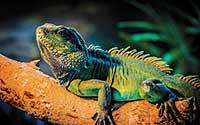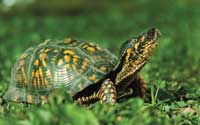One of the best parts of Moab is the rare and elusive wildlife we have here in the desert. A whole world of scaly scampering foot prints with a distinct tail drag mark give us a peak into an elusive lizard world, but some of us chose to have these creatures as part of our homes too!
There are a lot of things to know about keeping exotic animals as pets but we here at the BARKery know that nutrition is everything! We believe that excellent nutrition can not only extend the life of your pet, but prevent many common problems that keep your pets from living to their fullest. In our research about crickets as nutrition we discovered that up to 90% of reptiles suffer from nutritional imbalance at some point in their lives. And it matters that you feed your pets living food too! If crickets come from a fishery they are most like raised as fishing bait, so feeding your insectivore or carnivore crickets that were made for feeding reptiles makes a big difference in the overall nutritional health of your pet. Dusting crickets is a way to supplement vitamins and minerals but crickets are excellent groomers and groom off around 50% of the dusting powder in as little as 90 seconds. What they ingest only stays in their digestive tract for 4 hours. So if your reptile doesn’t eat the crickets right away they get much less supplementation. 
In order to understand what may be lacking in a reptiles diet, you have to start with some basic food facts first. Reptile is a very wide description of animals, and there is no diet that is well suited for all of them. In fact, there are no commercial diets that work for any reptiles. Reptiles need fresh food, period. Whether it is protein for carnivores, insects for insectivores or greens for herbivores the consensus is fresh is best. There are big differences with categories too. Rattlesnakes and Bearded Dragons are both carnivores, yet rattlesnakes need to be fed weeks apart where bearded dragons need to be fed multiple times a week. Bearded dragons also digest some greens very well and do best with a 5% supplementation, whereas rattlesnakes do no need to eat greens. They get the same benefit from the greens in the digestive tract of the mammals they eat. So each animal needs very specific care to thrive.
The one thing that all reptiles have in common is that they need to be kept in a warm environment. Many people don’t know that ultraviolet (UV) light is required to properly metabolize all nutrition, but especially calcium. Coincidentally the most common dietary deficiency in reptiles is calcium. So by providing a properly warmed environment with adequate UV light your exotic buddy can absorb all the nutrients and utilize the food you feed them.
The most common thing to feed carnivores and insectivores are crickets. They are easy to keep, care for and can be nutritious if they are feed the right things. They are also active prey and can help simulate hunting behaviors in your scaly friend. They provide a decent amount of protein, are lower in fat than other feeding options and come on a wide variety of sizes. When you compare wild caught insects with properly raised insects made for reptile food, you will find an abundance of vitamin A and E, both essential for a long healthy life. Although they are the most common form of food for reptiles, they don’t usually offer the complete package as a protein. They lack calcium, which is very important to reptiles so a variety of insects is the key to proper nutrition. Crickets can be a staple in your reptile’s diet, but make sure there are alternatives available. Crickets aren’t everything.
 So what else is necessary for good reptile nutrition? Depending on the animal there are some fantastic ways to provide alternative nutrition It’s all about worms. What do worms have that crickets don’t? In general worms have more fat and less fiber, with soft bodies that are easier to digest. Some species of worms are higher in vitamin A than any other type of feeder insect including crickets. It also happens to be that right behind calcium deficiency; vitamin A is also a critical nutrient that is missing from many reptile diets. So by feeding certain types of worms you will making a big difference in the nutrition your pet gets. There is also the fact that worms are easier to handle, ship, store and maintain. There are a wide variety of species that can provide great nutrition when they are made a part of the standard feeding regiment, and often small quantities are available to supplement a diet that is mostly crickets. There are even species of worms (Hermeia illucens) that are high in calcium and low in fat, they can be fed to supplement calcium while still providing fresh live prey. The only drawback to a diet that consists mostly of worms is fat! Even reptiles are facing the obesity epidemic that many of our furry pets are up against. We recommend using worms as a supplemental part of a reptile diet. So what else is necessary for good reptile nutrition? Depending on the animal there are some fantastic ways to provide alternative nutrition It’s all about worms. What do worms have that crickets don’t? In general worms have more fat and less fiber, with soft bodies that are easier to digest. Some species of worms are higher in vitamin A than any other type of feeder insect including crickets. It also happens to be that right behind calcium deficiency; vitamin A is also a critical nutrient that is missing from many reptile diets. So by feeding certain types of worms you will making a big difference in the nutrition your pet gets. There is also the fact that worms are easier to handle, ship, store and maintain. There are a wide variety of species that can provide great nutrition when they are made a part of the standard feeding regiment, and often small quantities are available to supplement a diet that is mostly crickets. There are even species of worms (Hermeia illucens) that are high in calcium and low in fat, they can be fed to supplement calcium while still providing fresh live prey. The only drawback to a diet that consists mostly of worms is fat! Even reptiles are facing the obesity epidemic that many of our furry pets are up against. We recommend using worms as a supplemental part of a reptile diet.
There is no one perfect insect for your reptile, so the biggest lesson is to provide variety. Make sure that they are getting the best quality insects possible that are raised to be fed to your pet and not just for fishing bait. Consider not just the quality of feed, but the temperature you keep your reptile so they can properly utilize the nutrition being fed to them. Most of all make sure to seek out expert nutritional advice and veterinary care to keep you scaly, slithering and swimming reptiles happy and healthy. |